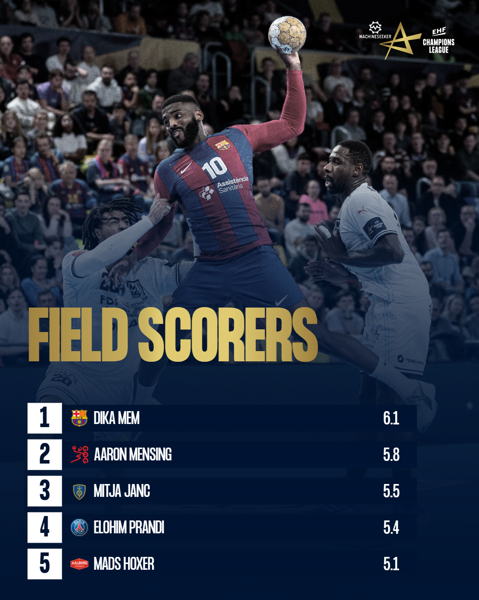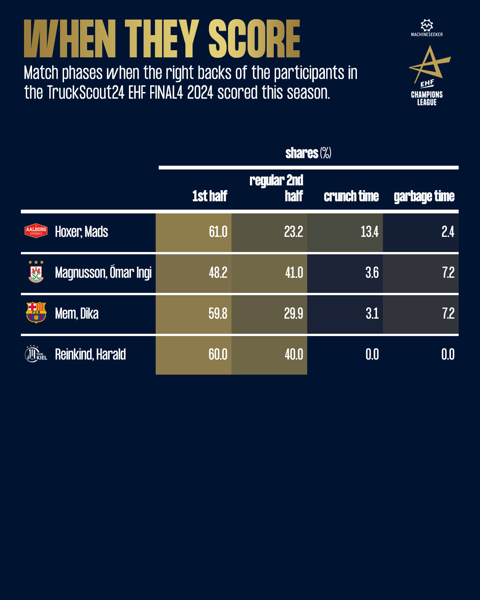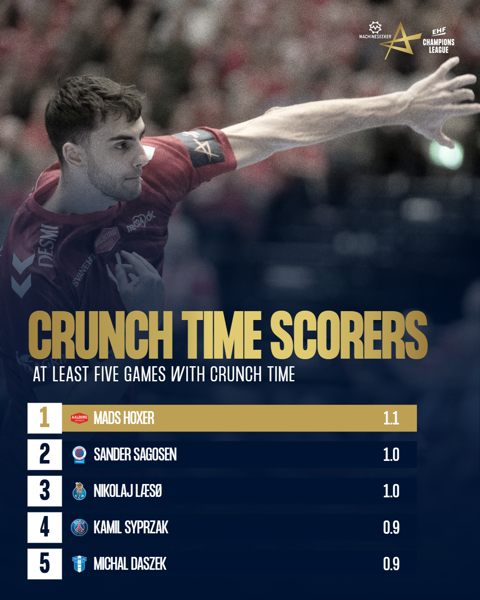For three out of the four TruckScout24 EHF FINAL4 2024 participants, right backs are their best scorers. Barça’s Dika Mem is the fourth-best scorer of the Machineseeker EHF Champions League with 6.1 goals per game. SC Magdeburg’s best scorer is Ómar Ingi Magnusson with 5.2 goals per game, while Aalborg Håndbold’s top player is Mads Hoxer with 5.1.
Only THW Kiel is a little out of line. Their first right back, Harald Reinkind, ranks just fifth in the team's internal scoring list with 3.1 goals per game. However, being out of line is of course a question of perspective. For Magnusson, 2.8 of his goals (55.4 per cent) are penalty throws, while the other three have not attempted a single seven-meter throw. Mem even leads among all field scorers, while Hoxer ranks fourth.

All four are integral parts of their teams’ strong offence. But here, too, THW falls slightly behind the other three. After Telekom Veszprém HC (31.1 goals per 50 possessions), Magdeburg has the second-best offence with 30.4, Barça is third with 30.1 and Aalborg is fourth with 29.5. The Zebras rank seventh with 28.3.
Different times of scoring
The four left-handers differ not only in seven-metre attempts, but also regarding at what time in the game they score. Some players come on strong when the game is on a knife-edge, others are already strong at the start and help the team gain a lead or stay in the game.
Therefore, a handball game can be divided into three times: crunch time, garbage time and regular time. The majority of a game can be summarised under regular time, which can be divided again into the first and the second half. When things get tight at the end of a game and everything is at stake, we are in crunch time. If the game is decided and both teams have subbed out most of their most important players, we speak of garbage time.
It is of course difficult to define exactly when it is crunch time and garbage time, as this is often subjective. Crunch time was defined here as the last six minutes of all matches if the gap between the two teams was two goals or less at least once, as long as the game isn’t in garbage time. Garbage time is here if there are 15 or fewer minutes to play and the score difference is at least ten, or if there are 10 or fewer minutes to play and the score difference is at least seven, or if there are five or fewer minutes to play and the score difference is at least five. Everything that is in the first half is considered “first half regular time” while everything that is neither crunch time nor garbage time is “second half regular time”.
Here, the four right backs differ significantly. Mem, Hoxer and Reinkind all scored well over half of their goals in the first half. All three are very close together with around 60 per cent. Only Magnusson scores more in the second half than in the first (48.2 per cent).

Accordingly, in the second half, when it is neither crunch time nor garbage time, Magnusson scores the highest proportion of goals with 41.0 per cent. But for Reinkind, it is just one percentage point less, as he doesn’t score in both crunch time and garbage time. Kiel’s only right back player with one single crunch time goal is Eduardo Gurbindo. Their only right back that scored in garbage time is Steffen Weinhold, who scored twice when the game was already decided.
Crunch time king Hoxer
Hoxer, in contrast, is the player who scored the lowest percentage of his goals in the second half – excluding garbage time and crunch time – among all players that scored at least 50 goals, with 23.2 per cent. But with 29.9 per cent, Mem isn’t too far away either.
In crunch time, however, nobody comes close to Hoxer. The Dane scores 13.4 per cent of his goals when the game is on the line, the highest among all players with at least 50 goals. Reinkind, as well as Magnusson (3.6 per cent) and Mem (3.1 per cent) don’t come close to that at all.
However, Hoxer also had the most opportunities to score in crunch time, as only Industria Kielce had more games that went into crunch time (12) than Aalborg (10). Kiel and Magdeburg were around average with six and eight, while Barça played the fewest crunch times with just four.
But Hoxer’s strength in the deciding moments is not only influenced by the many crunch times he played. In relative terms, he is also the best scorer among all players with appearances in at least five games with crunch time, with 1.1 goals per crunch time game. On top, he also has an outstanding shooting percentage of 91.7 per cent. He only missed one shot when the game was all to play for.

In garbage time, the four players do not have high shares. That is hardly surprising since they are all important players for their teams and usually get taken off when the game is decided.
Over the whole game, Mem has the best shooting percentage among all backcourt players with at least 70 shots and 71.9 per cent. This includes back court players, such as Magnusson, that shoot the penalty throws.
Excluding penalties, he obviously leads the same ranking as well, while Hoxer is fifth with 65.1 per cent. Magnusson and Reinkind didn’t attempt 70 shots from the field, but still have shooting percentages that are well above average with 63.8 per cent and 65.1 per cent, respectively. So, even if they are different, the four right backs will certainly leave their mark on the TruckScout24 EHF FINAL4 2024 because they are extremely good handball players.
More from data analyst Julian Rux can be found at Handballytics.de. There you can read his latest articles, in which he analyses all kinds of handball topics from new, data-based perspectives. You can also find him on Instagram, Facebook, X/Twitter, Threads and WhatsApp Channels.
Main photo © Victor Salgado









